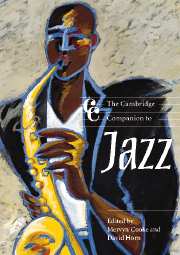Book contents
- Frontmatter
- The word jazz
- Part One Jazz times
- Part Two Jazz practices
- 5 Jazz as musical practice
- 6 Jazz as cultural practice
- 7 Jazz improvisation
- 8 Spontaneity and organisation
- 9 Jazz among the classics, and the case of Duke Ellington
- Part Three Jazz changes
- Part Four Jazz soundings
- Part Five Jazz takes
- Notes
- Works cited
- Principal musicians cited
- Index
9 - Jazz among the classics, and the case of Duke Ellington
from Part Two - Jazz practices
Published online by Cambridge University Press: 28 September 2011
- Frontmatter
- The word jazz
- Part One Jazz times
- Part Two Jazz practices
- 5 Jazz as musical practice
- 6 Jazz as cultural practice
- 7 Jazz improvisation
- 8 Spontaneity and organisation
- 9 Jazz among the classics, and the case of Duke Ellington
- Part Three Jazz changes
- Part Four Jazz soundings
- Part Five Jazz takes
- Notes
- Works cited
- Principal musicians cited
- Index
Summary
There is [in 1957] an increasing interrelationship between the adherents to art forms in various fields. Contemporary jazz, for instance, has many enthusiastic listeners in its audience who are classical musicians of heroic stature. Indeed, some classical musicians in recent years have involved themselves with jazz as composers, soloists, or both. I am not pointing this out in any attempt to plead for tolerance, for jazz is not in need of tolerance, but of understanding and intelligent appreciation. Moreover, it is becoming increasingly difficult to decide where jazz starts or where it stops, where Tin Pan Alley begins and jazz ends, or even where the borderline lies between classical music and jazz. I feel there is no boundary line, and I see no place for one if my own feelings tell me a performance is good.
[ellington 1973, 193]Currently one of the least fashionable ways of looking at jazz is from the perspective of ‘classical’ music – a label still used in record shops, and still understood instinctively by almost everybody, in spite of its avoidance by commentators who have yet to find an acceptable substitute. (Of the alternative terms, ‘art music’ is just as politically incorrect as ‘classical’, while ‘concert music’ can be applied to almost everything; in America, classical music is deemed to be ‘European’ in a simplistic antithesis to African-American traditions.) The once common notion that jazz might be thought of as ‘America's classical music’ has long been discredited. Yet no amount of quibbling about labels will make the parallels between the classical and jazz worlds go away; and those who insist on the uniqueness of jazz and its incompatability with essential characteristics of classical music cut themselves off from the richness of allusion and crossover at the heart of all the best western music of the twentieth century. It was perhaps because of this limited outlook that Duke Ellington, on his own admission, stopped using the word ‘jazz’ in 1943 (ibid., 452).
- Type
- Chapter
- Information
- The Cambridge Companion to Jazz , pp. 153 - 174Publisher: Cambridge University PressPrint publication year: 2003
- 1
- Cited by

